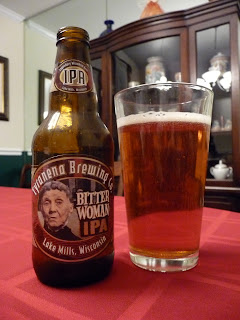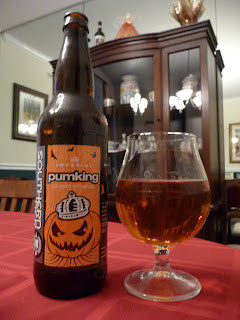I have mentioned in the past that both Clare and I are part of a monthly wine club. One couple cooks a four course meal, another couple pairs wines for each course, and everyone gets to enjoy the food and wine. For October 2011, we were responsible for choosing the wines. The couple who were cooking the meal planned to make a four course, Spanish meal. They really wanted to prepare a dinner using the cuisine of a country with an established wine culture. So, I undertook the challenge to pair Spanish wines with the Spanish courses.
Although it may seem easy to pair Spanish wines with Spanish cooking, I wanted to see if I could tap into the various styles and grapes grown throughout Spain. This is a challenge because Spain has more than sixty-five DOs (Denominación de Origen) and DOCa's (Denominación de Origen Calificada). These DOs and DOCa's cover the gamut, from white wines, to rose wines to red wines. I decided to pick a different wine style for each course, and, in addition, to pick a wine from different regions of Spain. No two wines could be the same style or from the same DO or DOCa, even if the wines were made from different grapes.
So, here are my wine choices, along with the pairing. A brief description of the winemaker (where available) and the wine is provided.
Muga Rioja Rose (2010)
Paired with Pan con Tomate y Jamon de Serrano (Tomato-Rubbed Bread with Serrano Ham)
Bodegas Muga is located in the Barrio de La Estación, which is the historic railway district of Haro, a small town in the northwest part of La Rioja. Muga's vineyards are located at the foot of the Montes Obarenses within an area called Rioja Alta. The soil is mostly clay and limestone, although there are some variations that help provide character to the grapes and, ultimately the wines. Muga has 620 acres of vineyards that it owns and the winery also gets grapes from an additional 370 acres of vineyards. The primary grapes grown for red wines in these vineyards are Tempranillo, Garnacha (Grenache), Mazuelo (Carignan) and Graciano. When it comes to white wines, the primary grapes grown in the vineyards are Viura and Malvasia.

The Bodegas Muga Rose is a blend of both red and white grapes. The blend is 60% Garnacha, 30% Viura and 10% Tempranillo. The wine is salmon pink in color. The aromatic elements of this wine are said to include a lot of different fruits: pears, peaches, passion fruit, pink grapefruit. One review even noted a little rhubarb. The tastes are said to be red berry fruit, with a little citrus zest and white pepper. A "mineral streak" is also noted by some reviewers. The body of this wine is light, and a little syrupy without being sweet.
I chose this wine to pair head to head with the Jamon de Serrano, kind of how Lambrusco is paired with Proscuitto in Emilia-Romagna. The light fruity flavors will also pair well with the use of fresh tomatoes, which are, after all, a fruit in and of themselves.
Gran Vinum Albariño Nessa (2009)
Paired with Hot Pepper and Garlic Shrimp
When one thinks of seafood, the thought in Spain first focuses on the region of Galicia. This region is renown for its seafood, so much so that the words "seafood" and "Galicia" could be synonyms. The second course features shrimp, along with crushed red pepper and garlic. These ingredients call for a white wine, but I wanted to pair this course with a wine from Galicia, which proved a little difficult.
Ultimately I chose an Albariño. The Albariño grape is grown in the Rias Biaxas D.O., which is found in southern Galicia, near the northern border of Portugal. The grape has a thick skin and produces less juice than other grapes, which may be due in part to the cool and rainy environment in Galicia. Yet, the Albariño wine is said to be very similar to Vigonier and Gewurztraminer, which are not grown in such wet conditions.
The grapes for the Gran Vinum Albariño Nessa are grown on a hillside near the Atlantic ocean by a winery that has been owned by the same family for three generations. The family, headed by Enrique Pineiro, also purchases grapes from other local vineyards to make this Albariño wine. Most of these growers are located in a sub-region of the Rias Biaxas D.O. called Val do Salnes. The wines are then picked and sorted by hand, pressed using a pneumatic press and fermented in stainless steel tanks.
The Albariño Nessa is gold in color. According to the reviewers, the aromatic elements of this wine are supposed to include peaches, flowers, jasmine and honeysuckle. The flavors are said to include oranges and limes, along with pit fruits. The medium body wine finishes with some more citrus and a "floral quality" in the finish.
Albariño wines are known for being dry to bone-dry. This feature of the wine highlights the spice and garlic without amplifying either flavor. However, this Albariño wine differs from other such wines in that it is not as dry, thereby rounding out the spice and garlic flavors of this shrimp dish.
Bodegas Bleda Castillo de Jumilla (2010)
Paired with Cocido Lebaniego (Cantabrian Meat Stew with Chickpeas)
The third course is a stew with pork (ham hocks, slab bacon, salt pork) and beef (veal shanks, dried beef). Initially, my thoughts turned to a full-bodied red wine, such as a Priorat or a Toro. However, Priorats and Toros are very full bodied, tannic wines that would be a little too "heavy" for this stew. After thinking about it a little longer, I decided to go with a medium bodied red, such as a Rioja. However, I already had a Rioja Rose. Moreover, Rioja is probably the most well-known Spanish wine. I wanted to find a different wine, one that may not be as well known.
So I chose the Bodegas Bleda Castillo de Jumilla. This wine comes from the Jumilla DO, which is an arid region located in the southern Spanish region of Murcia. This DO is most known for the indigenous grape Monastrell. This is a thick skinned, black grape that is high in tannin. It is reportedly difficult to grow, with inconsistent results from year to year.
The Castillo de Jumilla is a blend of 50% Monastrell and 50% Tempranillo. Each grape contributes to the overall wine. The wine is a bright violet in color. The Tempranillo provides a lot of fruit to the aroma and the taste. This fruit includes strawberries. However, the Monastrell deepens the fruit aromas and flavors, most notably with dark berry flavors. The layering of fruit flavors should produce an interesting wine. The winemaker adds that the aromas include, not just berries, but also licorice
This wine is a "joven," which is a term for a DO or DOCa wine that sees little to no time in an oak barrel. Instead, the wine is sold as "fresh" and/or "fruity."
I ultimately decided on this wine to provide a contrast to the Cocido Lebaniego, pairing a fresh and fruity wine with a stew of meats and chickpeas. This wine was the biggest wild card because it was a last minute substitution for what I had been planning to buy for this particular pairing.
Mont Marcal Brut Cava Riserva (2008)
Paired with Tarta de Santiago (Almond Tart)
Tarta de Santiago is a Galician Almond Tart. First thought would be to pair a Galician wine; however, I paired an Albariño with the Hot and Garlic Shrimp dish. So, I needed to look for a white wine for a different region. Not just any white wine. I ultimately chose a Cava, Spain's answer to France's Champagne or Italy's Prosecco.
Cava is typically associated with the Catalunya region in Southeastern Spain. That is where most Cava is produced, although Spanish law provides that the sparkling wine may be made in other regions, such as Aragon, Extramadura and Navarra. Sticking true to my challenge, the Mont Marcal Bruit Cava is produced in Castellví de la Marca
, a small town outside of Barcelona, Spain.
Cava is typically produced with a blend of grapes, typically Macabeo, Parellada and Xarel-lo. Other grapes used to produce Cava include Chardonnay, Pinot Noir and Subirat. The Mont Marcal is a blend of 40% Xarel-Lo, 30% Macabeo, 20% Parellada and 10% Chardonnay. Each grape is picked and fermented separately. The grapes are blended and go through a second fermentation in the bottle for at least fifteen months.
The winemaker describes this wine as having a pale yellow color, with good carbonation and "a perfect mousse." The aromatic elements and taste include apples, banana and pineapple. The body of this wine is slightly sweet and crisp. Although Cava is typically an aperitif, I decided to go with this wine because the lightness of this wine will help with digestion, particularly after three course and three different wines. In addition, the carbonation of the wine will help to cleanse the palate, allowing the guests to enjoy the almond tart.
There you have it -- a sparkling wine from Catalunya, a white wine from Galicia, a rose wine from La Rioja, and a red wine from Jumilla. Four different styles of wines from four different regions of Spain paired with four different courses. All of these wines are available at Calvert Woodley in Washington, D.C.
ENJOY!











































